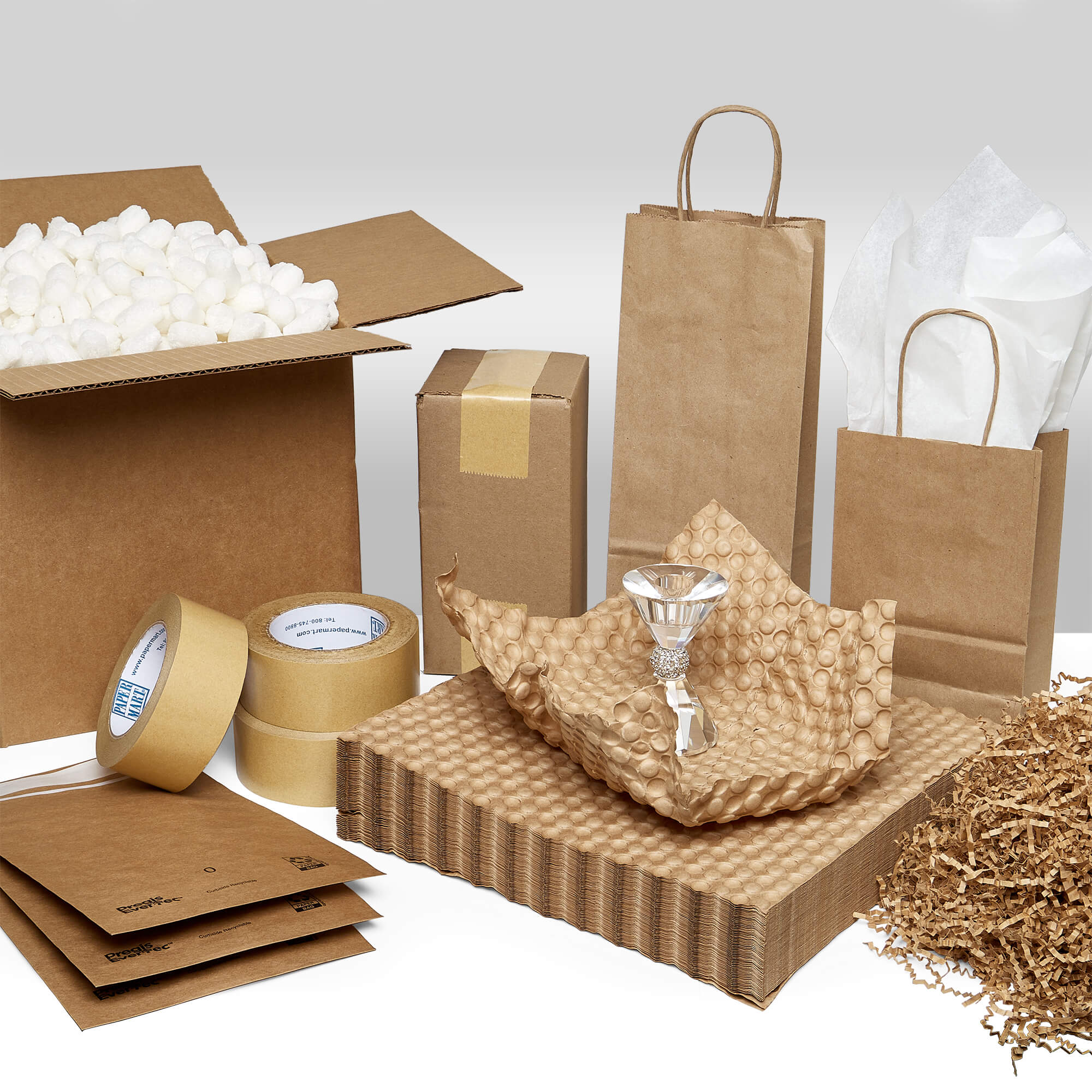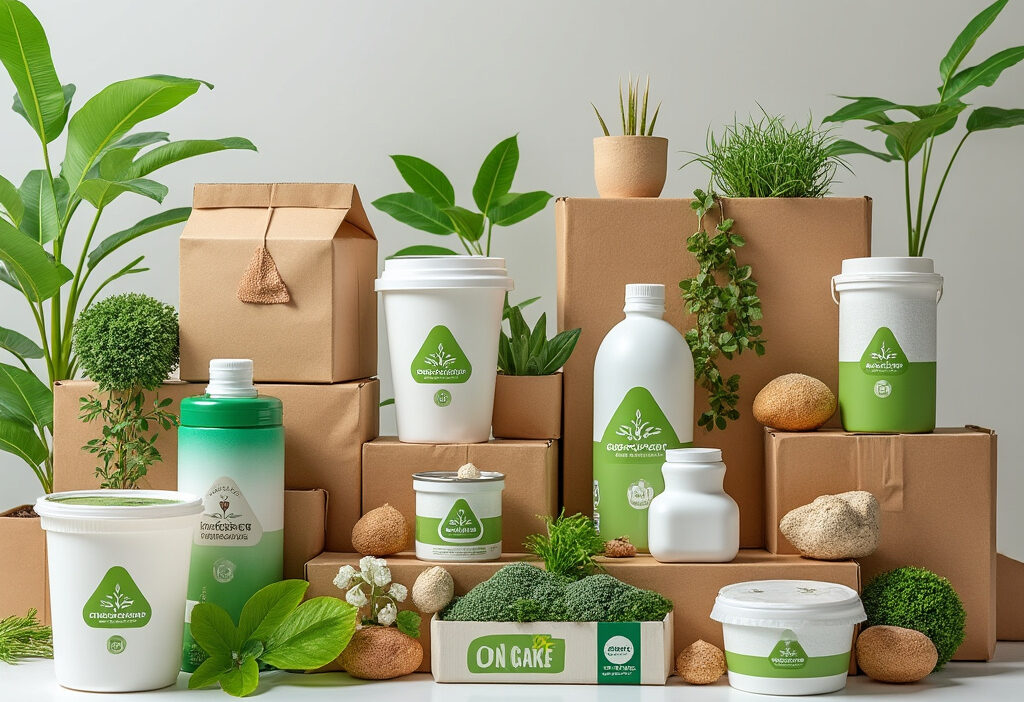Sustainable Packaging Solutions – How Eco-Friendly Materials Are Shaping the Future of Business in 2025
The sustainable packaging market is witnessing unparalleled growth in 2025, driven by a surge in consumer demand for eco-friendly options, innovative technological advancements, and stringent environmental regulations. This article delves into the transformative impact of sustainable packaging solutions on the business landscape, highlighting the shift towards materials and practices that promise a greener, more sustainable future.
The Rise of Sustainable Packaging
The packaging industry is undergoing a radical transformation as businesses pivot toward sustainable materials to meet both regulatory pressures and shifting consumer expectations. By 2025, eco-friendly packaging is no longer a niche trend but a fundamental expectation, reshaping how companies approach design, logistics, and waste reduction. The rise of biodegradable, compostable, and recyclable materials is redefining supply chains, with innovations like mycelium-based packaging and algae-derived plastics gaining traction.
A key driver of this shift is the growing awareness of packaging’s environmental footprint. Businesses are now prioritizing lifecycle assessments to evaluate the ecological impact of their packaging choices, from raw material extraction to end-of-life disposal. For instance, traditional plastic, once ubiquitous, is being replaced by plant-based alternatives like PLA (polylactic acid) and PHA (polyhydroxyalkanoates), which decompose under industrial composting conditions. Meanwhile, mono-material packaging—using a single recyclable material instead of layered composites—is simplifying recycling processes and reducing contamination.
Designers are also embracing minimalist packaging, eliminating unnecessary layers and opting for lightweight materials that lower transportation emissions. Companies like Loop are pioneering reusable packaging models, where containers are returned, sanitized, and reused, creating a circular economy. These innovations aren’t just environmentally sound—they’re proving cost-effective in the long run by cutting waste disposal fees and enhancing brand loyalty among eco-conscious consumers.
The environmental impact is undeniable: reduced landfill waste, lower carbon emissions, and decreased reliance on fossil fuels. As businesses integrate sustainability into core operations, the packaging industry is setting a precedent for other sectors to follow, proving that profitability and environmental responsibility can coexist.
Consumer Preferences and Market Dynamics
Consumer preferences are undergoing a radical transformation, with sustainability now a non-negotiable factor in purchasing decisions. A 2024 NielsenIQ report revealed that 78% of global consumers prioritize eco-friendly packaging, up from 62% in 2020. This shift is not just a trend but a fundamental driver of market dynamics, compelling brands to rethink their packaging strategies. The demand for recyclable, compostable, and reusable options has surged, with the global sustainable packaging market projected to reach $413 billion by 2025, growing at a CAGR of 7.2%.
The rise of conscious consumerism is reshaping the packaging industry. Younger demographics, particularly Gen Z and Millennials, are leading this charge, with 85% willing to pay a premium for sustainable packaging, according to a 2023 McKinsey survey. This has forced businesses to adopt transparent labeling, such as How2Recycle certifications, to meet consumer expectations. Retail giants like Amazon and Walmart have responded by setting ambitious targets for 100% recyclable or compostable packaging by 2025, further accelerating industry-wide adoption.
Market dynamics are also influenced by regulatory pressures and corporate sustainability goals. The EU’s Single-Use Plastics Directive and similar policies in the U.S. and Asia are pushing companies toward greener alternatives. Startups like Notpla (seaweed-based packaging) and Loop Industries (circular recycling solutions) are gaining traction, backed by venture capital investments exceeding $2.5 billion in 2024 alone. The packaging industry’s future hinges on aligning with these evolving preferences, as businesses that fail to adapt risk losing market share to more sustainable competitors.
This consumer-driven revolution sets the stage for the next chapter, where technological innovations will further redefine what’s possible in sustainable packaging.
Technological Innovations in Eco-Friendly Packaging
Technological Innovations in Eco-Friendly Packaging
As consumer demand for sustainable packaging grows, businesses are turning to cutting-edge technologies to meet these expectations without compromising functionality. The rise of biodegradable materials is a prime example, with innovations like algae-based polymers and mushroom mycelium packaging gaining traction. These materials decompose naturally, reducing landfill waste, while advanced manufacturing techniques ensure they match the durability of traditional plastics.
Smart packaging is another breakthrough, integrating IoT sensors and QR codes to enhance sustainability. These solutions allow consumers to track a product’s lifecycle, verify its eco-credentials, and even receive recycling instructions—bridging the gap between convenience and environmental responsibility. For businesses, this technology improves supply chain transparency, fostering trust and compliance with sustainability regulations.
The circular economy is also reshaping packaging design. Companies are adopting closed-loop systems where materials are continuously repurposed. Innovations like chemical recycling break down plastics at a molecular level, enabling infinite reuse without degradation. Meanwhile, edible packaging—made from seaweed or rice starch—eliminates waste entirely, offering a zero-impact alternative for food and beverage industries.
These advancements are not just theoretical; they’re setting new industry benchmarks. For instance, major brands now use plant-based PLA (polylactic acid) for rigid packaging, while startups experiment with water-soluble films for single-use items. As technology evolves, the line between sustainability and performance blurs, proving that eco-friendly packaging can be both viable and profitable. The next chapter will explore how compostable and biodegradable materials are further revolutionizing this space.
The Shift Towards Compostable and Biodegradable Materials
The shift toward compostable and biodegradable materials is gaining momentum as businesses prioritize sustainability without compromising functionality. Unlike traditional plastics derived from fossil fuels, these materials break down naturally, reducing landfill waste and microplastic pollution. Polylactic acid (PLA) and polyhydroxyalkanoates (PHA) are leading the charge—PLA, made from fermented plant starch, offers clarity and rigidity akin to conventional plastics, while PHA, produced by microbial fermentation, excels in marine biodegradability. Both materials decompose under industrial composting conditions, leaving minimal environmental residue.
Standards such as ASTM D6400 and EN 13432 ensure these materials meet strict compostability criteria, verifying they disintegrate within 12 weeks and biodegrade by 90% within six months. However, challenges persist, including the need for specialized composting facilities and consumer education to prevent contamination in recycling streams. Despite this, brands like Eco-Products and TIPA are pioneering food-grade compostable packaging, proving feasibility at scale.
The environmental benefits are substantial:
- Reduced carbon footprint – Plant-based materials sequester CO2 during growth, offsetting emissions.
- Soil enrichment – Compostable packaging decomposes into nutrient-rich humus, supporting circular agriculture.
- Marine safety – Unlike petroleum plastics, PHA breaks down harmlessly in water, addressing ocean pollution.
As regulatory pressures mount—such as the EU’s Single-Use Plastics Directive—businesses are investing in these alternatives to future-proof operations. The next frontier, water-soluble and edible packaging, builds on this momentum, offering even more radical waste reduction. For now, compostable and biodegradable materials bridge the gap between functionality and sustainability, reshaping packaging norms for 2025 and beyond.
Water-Soluble and Edible Packaging Innovations
As businesses continue to seek innovative ways to reduce packaging waste, water-soluble and edible packaging have emerged as groundbreaking solutions. Unlike compostable materials, which still require specific conditions to break down, these innovations dissolve or can be consumed, leaving no trace behind. Water-soluble films, often made from polyvinyl alcohol (PVA) or seaweed-based polymers, dissolve completely in water, making them ideal for single-use applications like detergent pods, agrochemicals, or even food-grade packaging. Meanwhile, edible packaging, crafted from natural ingredients like starch, algae, or proteins, offers a zero-waste alternative for snacks, condiments, and beverages.
The science behind these materials is fascinating. Water-soluble films rely on hydrophilic polymers that disintegrate upon contact with water, while edible packaging leverages food-grade binders to create durable yet digestible barriers. Companies like Notpla have pioneered edible seaweed-based sachets for sauces, and Monosol has commercialized dissolvable laundry pods, proving the viability of these solutions. The applications extend beyond consumer goods—hospitals use soluble packaging for sterile tools, reducing plastic waste in medical settings.
The potential for waste reduction is immense. If adopted at scale, these materials could drastically cut down on landfill contributions and marine pollution, addressing one of the most persistent environmental challenges. However, challenges remain, such as ensuring durability during transport and overcoming consumer skepticism about edible options. Despite these hurdles, the business case is strong: brands adopting these innovations can differentiate themselves as sustainability leaders while meeting tightening regulatory standards.
As we transition toward a circular economy, these materials represent a critical step in rethinking packaging’s lifecycle—shifting from disposal to disappearance or consumption. The next chapter will explore how reusable systems complement these innovations, creating a holistic approach to sustainable packaging.
Embracing the Circular Economy
As businesses continue to shift toward sustainable packaging, the circular economy has emerged as a transformative framework for minimizing waste and maximizing resource efficiency. Unlike traditional linear models—where materials are used once and discarded—circular packaging strategies prioritize reuse, refurbishment, and recycling to keep materials in circulation for as long as possible. A prime example of this shift is the growing adoption of Reusable Plastic Containers (RPCs), which are revolutionizing supply chains in industries like agriculture, retail, and logistics.
RPCs are designed for multiple lifecycles, reducing the need for single-use alternatives like cardboard or disposable plastics. Studies show that RPCs can cut packaging waste by up to 86% while lowering transportation costs due to their stackable and durable design. Companies like Walmart and IKEA have integrated RPCs into their operations, demonstrating how reusable systems align with both sustainability goals and economic efficiency. Beyond cost savings, these systems help businesses meet regulatory requirements and consumer demands for greener practices.
The circular economy also encourages innovative business models, such as packaging-as-a-service, where companies lease containers to suppliers and retailers, ensuring proper collection and refurbishment. This approach not only reduces environmental impact but also fosters long-term partnerships across the supply chain. Additionally, advancements in material science—such as high-performance polymers—enhance the durability of reusable packaging, making it viable for more applications.
By embracing circular principles, businesses are not just reducing waste—they are building resilient, future-proof systems. As the next chapter explores, integrating smart technologies with these sustainable models will further optimize traceability and consumer engagement, creating a seamless loop between production, use, and recovery.
The Impact of Smart Sustainable Packaging
The integration of smart technologies into sustainable packaging is revolutionizing how businesses approach environmental responsibility while enhancing functionality. As the circular economy gains traction, smart packaging bridges the gap between sustainability and digital innovation, offering traceability, engagement, and waste reduction. Printed electronics and QR codes are at the forefront of this transformation, embedding intelligence into eco-friendly materials without compromising their recyclability or compostability.
Printed electronics enable packaging to communicate with consumers and supply chains. Thin, flexible circuits printed with conductive inks can monitor temperature, humidity, or freshness, ensuring product integrity while reducing food waste. For instance, a biodegradable milk carton with embedded sensors can alert consumers via smartphone if the contents are nearing spoilage. This not only minimizes waste but also builds trust through transparency.
QR codes take consumer engagement a step further. Scannable codes on plant-based or recycled packaging provide instant access to detailed product origins, recycling instructions, or even loyalty rewards. Brands like Patagonia and L’Oréal use QR codes to share sustainability stories, turning packaging into an interactive platform that educates and incentivizes responsible disposal.
Smart packaging also enhances traceability across supply chains. Blockchain-linked QR codes allow businesses and consumers to track a product’s journey, verifying ethical sourcing and carbon footprint. This level of accountability aligns with circular economy principles by ensuring materials are recovered and reused efficiently.
As minimalist design trends reduce material use (as explored in the next chapter), smart features ensure that less doesn’t mean lesser functionality. Instead, it creates a synergy where sustainability, technology, and consumer experience converge, shaping a future where packaging is as intelligent as it is eco-conscious.
Minimalist Design and Material Reduction
As businesses strive to align with sustainability goals in 2025, minimalist packaging design and material reduction have emerged as key strategies. This approach goes beyond aesthetics—it’s a calculated move to reduce waste, lower costs, and meet consumer demand for eco-conscious products. By stripping packaging down to its essentials, companies are minimizing their environmental footprint while maximizing efficiency.
The shift toward minimalism is driven by several factors. First, reducing material use directly decreases the carbon footprint of production and transportation. Lighter packaging means fewer emissions during shipping, a critical factor as logistics networks push for decarbonization. Second, simplified designs often eliminate unnecessary layers, adhesives, and inks, making recycling easier and reducing contamination in waste streams. Brands like Apple and Lush have pioneered this trend, proving that sleek, functional packaging can enhance brand perception while cutting costs.
Material reduction also offers financial benefits. Fewer materials translate to lower production expenses and reduced shipping weights, which can significantly impact supply chain costs. Additionally, minimalist packaging resonates with today’s consumers, who increasingly favor brands that prioritize sustainability without compromising quality. A Nielsen study found that 73% of global consumers are willing to pay more for products with eco-friendly packaging—making minimalism not just an environmental choice but a competitive advantage.
However, this trend isn’t without challenges. Stripping back materials requires careful engineering to maintain product protection and shelf appeal. Companies must balance simplicity with functionality, ensuring that reduced packaging doesn’t lead to higher damage rates or diminished brand recognition. As regulations tighten (a topic explored in the next chapter), businesses must also ensure their minimalist designs comply with evolving sustainability standards.
In 2025, minimalist packaging is more than a trend—it’s a necessity. By embracing material reduction, companies are future-proofing their operations, reducing waste, and appealing to a growing base of eco-aware consumers.
Regulatory Landscape and Compliance Challenges
As businesses increasingly adopt minimalist packaging and material reduction strategies, they must also navigate a rapidly evolving regulatory landscape. Governments worldwide are tightening sustainability mandates, pushing companies to rethink compliance while maintaining efficiency. In 2025, regulations like the EU Packaging and Packaging Waste Regulation (PPWR) and Extended Producer Responsibility (EPR) schemes are setting stringent targets for recyclability, biodegradability, and reduced carbon footprints. These policies aim to curb plastic pollution and promote circular economies, but they also introduce complex challenges for businesses.
One major hurdle is the lack of global standardization. While the EU enforces strict rules, other regions like Asia and North America have fragmented policies, forcing multinational corporations to juggle varying compliance requirements. For instance, some countries mandate compostable packaging, while others prioritize recycled content—creating logistical and cost burdens. Additionally, smaller businesses often struggle with the high costs of transitioning to compliant materials, such as bio-based plastics or reusable packaging systems.
To adapt, companies are investing in regulatory intelligence tools and collaborating with policymakers to shape future guidelines. Many are also leveraging lifecycle assessments (LCAs) to ensure their packaging meets both current and anticipated regulations. For example, food brands are shifting from multi-layer plastics to mono-materials that are easier to recycle, aligning with impending bans on hard-to-process packaging.
The regulatory push is also accelerating innovation. Startups are developing advanced materials like algae-based films and edible coatings, which not only comply with laws but also resonate with eco-conscious consumers. As the next chapter will explore, these innovations are just the beginning of a broader transformation in sustainable packaging, driven by both policy and market demand.
Looking Ahead – The Future of Sustainable Packaging
As the regulatory landscape tightens and consumer demand for sustainability grows, the packaging industry is poised for transformative change by 2025. Emerging technologies and material innovations will redefine what eco-friendly packaging looks like, driven by both necessity and opportunity.
One of the most significant trends will be the rise of smart packaging, integrating biodegradable materials with embedded sensors to track freshness, reducing food waste while maintaining sustainability. Advances in nanotechnology will enable ultra-thin, yet durable, barrier coatings for compostable packaging, extending shelf life without relying on plastics. Meanwhile, algae-based polymers and mycelium packaging will gain traction as scalable, carbon-neutral alternatives, offering performance comparable to traditional materials without environmental trade-offs.
Consumer behavior will further shape the market, with a shift toward reusable and refillable systems becoming mainstream. Brands will adopt circular models, partnering with logistics providers to streamline returnable packaging networks. Digital platforms will facilitate this transition, using blockchain to verify the lifecycle of materials and ensure transparency.
Global sustainability goals, such as the UN’s 2030 Agenda, will accelerate investment in closed-loop recycling infrastructure, making post-consumer materials more accessible. Chemical recycling breakthroughs will allow previously non-recyclable plastics to be broken down at a molecular level, reducing landfill dependency.
However, challenges remain—scaling these innovations requires significant capital, and industries must balance cost with ecological benefits. Yet, as regulations push for stricter compliance and consumers reward sustainable brands, businesses that adopt these solutions early will gain a competitive edge. The future of packaging isn’t just green; it’s intelligent, circular, and inevitable.

Conclusions
As we navigate through 2025, the sustainable packaging revolution is undeniably reshaping the business world. Companies are increasingly investing in eco-friendly packaging solutions to meet consumer demand, comply with regulations, and contribute to environmental sustainability. The continuous innovation in materials and practices highlights a promising future where sustainable packaging is not just a trend, but a standard for all.



